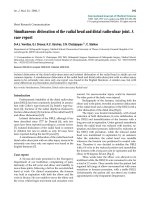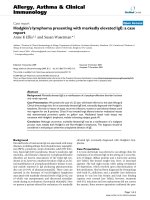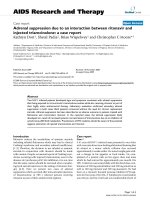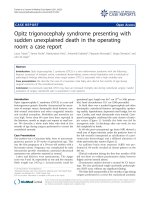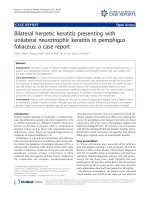Báo cáo y học: "Addison’s disease presenting with idiopathic intracranial hypertension in 24-year-old woman: a case report." pptx
Bạn đang xem bản rút gọn của tài liệu. Xem và tải ngay bản đầy đủ của tài liệu tại đây (325.72 KB, 3 trang )
CAS E REP O R T Open Access
Addison’s disease presenting with idiopathic
intracranial hypertension in 24-year-old woman:
a case report
Dushyant Sharma
1
, Rohini Mukherjee
1
, Peter Moore
2
, Daniel J Cuthbertson
1*
Abstract
Introduction: Idiopathic intracranial hypertension can rarely be associated with an underlying endocrine disorder
such as Cushing’s syndrome, hyperthyroidism, or with administration of thyroxine or growth hormone. Though
cases of idiopathic intracranial hypertension associated with Addison’s disease in children have been reported,
there is only one documented case report of this association in adults. We describe a case of an acute adrenal
insufficiency precipitated by idiopathic intracranial hypertension in a Caucasian female.
Case presentation: A 24-year-old Caucasian woman was acutely unwell with a background of several months of
generalised fatigue and intermitten t headaches. She had unremarkable neurological and systemic examination with
a normal computerised tomography and magnetic resonance imaging of the brain. Normal cerebrospinal fluid but
increased opening press ure at lumbar puncture suggested intracranial hypertension. A flat short synacthen test and
raised level of adrenocorticotrophic hormone were consistent with primary adren al failure.
Conclusion: Addison’s disease can remain unrecognised until precipitated by acute stress. This case suggests that
idiopathic intracranial hypertension can rarely be associated with Addison’s disease and present as an acute illness.
Idiopathic intracranial hypertension is possibly related to an increase in the levels of arginine vasopressin peptide in
serum and cerebrospinal fluid secondary to a glucocorticoid deficient state.
Introduction
Idiopathic intracranial hypertension (IIH) describes the
clinical syndrome of raised intracranial pressure, in the
absence of space-occupying lesions or vascular lesions,
without enlargement of the cerebral ventricles, for
which no causative factor can be identified [1]. The con-
dition is frequently associated with obesity or with var-
ious drugs including antibiotics (tetracyclines,
nitrofurantoin, nalidixic acid), amiodarone, cyclosporin,
systemic and topical steroids or the oral contraceptive
pill. However, IIH is rarely associated with underlying
endocrine disorders such as Cushing’ ssyndrome,
hyperthyroidism or with the administratio n of thyroxine
or growth hormone. We describe the case of a woman
presenting with acute chronic adrenal insufficiency asso-
ciated with IIH. The pathophysiological mechanism pro-
posed is tha t the gluco- and mineralocorticoid deficient
state is accompanied b y a sustained overproduction of
anti-diuretic hormone (ADH) causing intracranial
hypertension.
Case presentation
A 24-year-old Caucasian woman was admitted to the
Accident and Emergency Department of our hospital
with a sudden episode of nausea, vomiting and collapse,
having become acutely unwell whilst at work. There was
no past med ical history and she was not taking any reg-
ular medication. On examination she was of normal
body weight (weight 53 kg and body mass index 21 kg/
m
2
), afebrile and her blood pressure was 103/56 with no
postural change measured. Although she appeared
drowsy and unwell, her systemic examination was unre-
markable and no focal abnormalities were found on
neurological examination of the central or peripheral
nervous system. Initial biochemical analysis revealed
sodium 127 mmol/l, potassium 3.2 mmol/l, urea 3.8
mmol/l, creatinine 77 and glucose 4.1 mmol/l.
* Correspondence:
1
Department of Diabetes and Endocrinology, Clinical Sciences Centre,
University Hospital Aintree, Liverpool L9 7AL, UK
Sharma et al. Journal of Medical Case Reports 2010, 4:60
/>JOURNAL OF MEDICAL
CASE REPORTS
© 2010 Sharma et al; licensee BioMed Central Ltd. This is an Open Access art icle d istributed under the terms of the Creative Commons
Attribution License ( which permits unrestricted use, distribution, an d reproduction in
any medium, provided the original work is properly cited.
Inflammatory markers (white cell count and C-reactive
protein) were normal. A computerised tomography (CT)
and magnetic resonance (MR) of the brain demonstrated
normal ventricles, no focal lesion or mass effect and
normal s agittal sinus flow. Upon lumbar puncture, per-
formed in the lateral decubitus position, an opening
pressure of 40 mm of water was documented. Cere-
brospinal fluid (CSF) microscopy revealed two white
blood cells (WBCs) per mm
3
, <1 red blood cell (RBC)
per mm
3
and no organisms. CSF chemistry was unre-
markable: protein 0.4 g/l and glucose 3.2 mmol/l. The
patient had remained drowsy and she was managed in
the Intensive Care Unit with a pres umptive diagnosis of
acute meningoencephalitis with a secondary syndrome
of inappropriate anti-diuretic hormone (SIADH). No
measurements of serum or urine osmolality were made.
She was treated with antibiotics and acyclovir and was
also supported with intravenous fluids and, within 24
hours, had improved such that she was transferred back
to the ward.
During subsequent review she admitted to several
months of generalised fatigue, sometimes falling asleep
at work, and of intermittent headaches. With subse-
quent neurology specialist input to review the grossly
elevated intracranial pressure, accompanied by normal
imaging and CSF analysis, the patient was commenced
on acetazolamide 250 mg daily for presumed idiopathic
intracranial hypertension (IIH). Visual acuity and visual
field (Goldman perimetry) testing was unremarkable.
On endocrine review, generalised hyperpigmentation
with facial melasma were noted and, although she had
no buccal pigmentation , she did have marked pigmenta-
tion of a recent scar over her left shoulder (Figure 1). A
short synacthen (250 mcg) test (SST) was performed
and demonstrat ed adrenal insufficiency with basal corti-
sol at 231 nmol/l, 30 minute cortisol 265 nmol/l and 60
minute at 200 nmol/l. A repeat SST sho wed basal corti-
solat138nmol/land30minutecortisolat159nmol/l
and confirmed adrenal insufficiency. Adrenal antibodies
were negative. Her plasma adrenocorticotropic hormone
(ACTH) was raised at >278 pmol/l consistent with pri-
mary adrenal failur e. She was commenced on
glucoco rticoid (hydrocortisone 10 mg bd) and mineralo-
corticoid ( fludrocortisone 50 mcg) replacement therapy
and discharged. On subsequent review two weeks later,
she was feeling much better with CSF pressure reduced
to 25 mm of water on repeat lumbar puncture. Acetazo-
lamide was discontinued after three months and on
subsequent reviews at six and 12 months, she continued
to remain well on hydrocortisone and f ludrocortisone
replacement.
Discussion
Idiopathic intracranial hypertension is defined as the
clinical syndrome of raised intracranial pressure, in the
absence of space-occupying lesions or vascular lesions,
without enlargement of the cerebral ventricles, for
which no causative factor can be identified [1]. Although
IIH is often associated with papilloedema, papilloedema
is not a n absolute requirement to make the diagnosis.
Historically IIH was referred to as pseudotumour cerebri
as it mimics an intracranial tumour. More recently, it
has been referred to as benign intracranial hypertension
although this term has also been abandoned because a
small but significant number of patients develop visual
impairment or visual loss. However, even t he current
term idiopathic intracranial hypertension is inaccurate
with the condition frequently associated with obesity or
with the use of medication including various antibiotics
(tetracyclines, nitrofurantoin, and nalidixic acid), amio-
darone, cyclosporin, systemic and topical steroids, and
the oral contraceptive pill. Of relevance, various endo-
crine disorders have also rarely been reported in associa-
tion with otherwise idiopathic intracranial hypertension
including Cushing’s syndrome [2], hyperthyroidism [3]
as well as the administration of thyroxine or growth
hormones [4]. There has only been one previous docu-
mented case of idiopathic intracranial hypertension
occurring in association with Addison’ sdiseaseinan
adult [5] with two further cases reported in children [6].
Although the pathophysiology of IIH is uncertain, the
mechanisms that have been proposed for its develo p-
ment include increased production of CSF, reduced CSF
absorption, o r increased cerebral venous pressure caus-
ing a secondary increase in C SF pressure. Analysis of
CSF arginine vasopressin (AVP) in patients with IIH
demonstrates it to be elevated compared to healthy con-
trols [7]. This would seem to correl ate with reports that
patients with glucocorticoid deficiency have increased
plasma levels of AVP and a sustained hypersecretion of
AVP despite plasma dilution [8]. Thu s it is possible that
increased serum, and possibly CSF AVP may mediate
IIH in Addison’s disease.
In this case, there are two weaknesses to acknowledge
with regards to demonstrating the likely association
between Addison’s disease and intracranial hypertension.
Figure 1 Facial and scar pigmentation.
Sharma et al. Journal of Medical Case Reports 2010, 4:60
/>Page 2 of 3
Firstly, we were unable to measure serum or CSF AVP
to provide the mechanistic link. Secondly, the patient’s
intracranial hypertension was treated with acetazolamide
and did not necessarily reduce solely as a consequence
of steroid replacement. However, standard treatment for
IIH was instituted in addition to steroid replacement to
minimise any risk of visual loss.
Conclusion
Addison’s disease can remain unrecognised for a long
time until acute adrenal insufficiency is precipitated by
an acute stress. This case suggests that IIH can rarely be
associated with Addison’ s disease and presents as an
acute illness. The association of IIH with Addison’sdis-
ease is possibly secondary to increased serum and CSF
arginine vasopressin peptide (AVP) in a glucocorticoid
deficient state. Though standard treatment of IIH is
acetazolamide, replacing steroids on identifying Addi-
son’ sdiseaseasthecausefortheconditionmight
reduce the risk of loss of vision and provide early symp-
tom relief.
Consent
Written informed consent was obtained from the patient
for the publication of this case report and accompanying
images. A copy of the written consent is available for
review by the Editor-in-chief of the journal.
Abbreviations
IIH: idiopathic intracranial hypertension; ADH: anti-diure tic hormone; CT:
computerised tomography; MR: magnetic resonance; CSF: cerebrospinal
fluid; WBC: white blood cells; RBC: red blood cells; SIADH: syndrome of
inappropriate anti-diuretic hormone; ACTH: adreno-corticotrophic hormone;
AVP: arginine vasopressin.
Acknowledgements
We acknowledge the support provided by chemical pathology, radiology
and the medical photography department at Aintree University Hospital,
Liverpool, UK.
Author details
1
Department of Diabetes and Endocrinology, Clinical Sciences Centre,
University Hospital Aintree, Liverpool L9 7AL, UK.
2
Department of Neurology,
Walton Centre for Neurology and Neurosurgery NHS Trust, Liverpool L9 7AL,
UK.
Authors’ contributions
RM organised the various investigations, collected information and
conducted the literature search. PM provided the neurological evaluation
while DJC and DS provided the endocrine evaluation along with a
contribution in writing the manuscript. All authors read and approved the
final manuscript.
Competing interests
The authors declare that they have no competing interests.
Received: 8 May 2008 Accepted: 19 February 2010
Published: 19 February 2010
References
1. Friedman DI, Jacobson DM: Diagnostic criteria for idiopathic intracranial
hypertension. Neurology 2002, 59:1492-1495.
2. Newman PK, Snow M, Hudgson P: Benign intracranial hypertension and
Cushing’s disease. Br Med J 1980, 281(6233):113.
3. Dickman MS, Somasundaram M, Brzozowski L: Pseudotumor cerebri and
hyperthyroidism. N Y State J Med 1980, 80(7 Pt 1):1118-1120.
4. Malozowski S, Tanner LA, Wysowski DK, Fleming GA, Stadel BV: Benign
intracranial hypertension in children with growth hormone deficiency
treated with growth hormone. J Pediatr 1995, 126(6):996-999.
5. Leggio MG, Cappa A, Molinari M, Corsello SM, Gainotti G: Pseudotumor
cerebri as presenting syndrome of Addisonian crisis. Ital J Neurol Sci
1995, 16(6):387-389.
6. Condulis N, Germain G, Charest N, Levy S, Carpenter TO: Pseudotumor
cerebri: a presenting manifestation of Addison’s disease. Clin Pediatr
(Phila) 1997, 36:711-713.
7. Seckl J, Lightman S: Cerebrospinal fluid neurohypophysial peptides in
benign intracranial hypertension. J Neurol Neurosurg Psychiatry 1988,
51(12):1538-1541.
8. Agus ZS, Goldberg M: Role of antidiuretic hormone in the abnormal
water diuresis of anterior hypopituitarism in man. J Clin Invest 1971,
50(7):1478-1489.
doi:10.1186/1752-1947-4-60
Cite this article as: Sharma et al.: Addison’s disease presenting with
idiopathic intracranial hypertension in 24-year-old woman: a case
report. Journal of Medical Case Reports 2010 4:60.
Submit your next manuscript to BioMed Central
and take full advantage of:
• Convenient online submission
• Thorough peer review
• No space constraints or color figure charges
• Immediate publication on acceptance
• Inclusion in PubMed, CAS, Scopus and Google Scholar
• Research which is freely available for redistribution
Submit your manuscript at
www.biomedcentral.com/submit
Sharma et al. Journal of Medical Case Reports 2010, 4:60
/>Page 3 of 3
